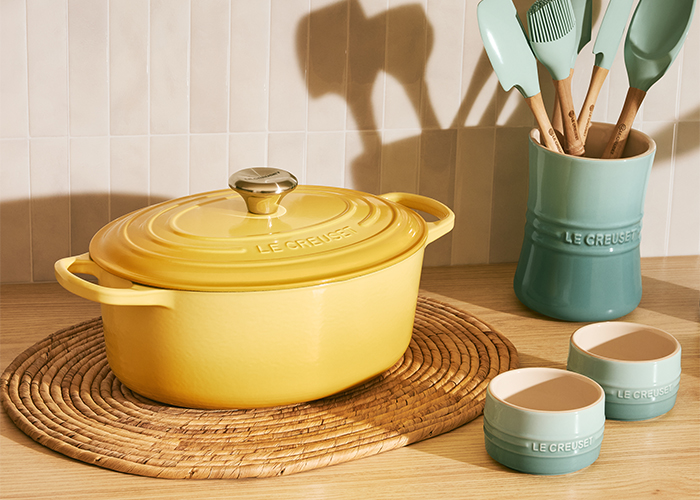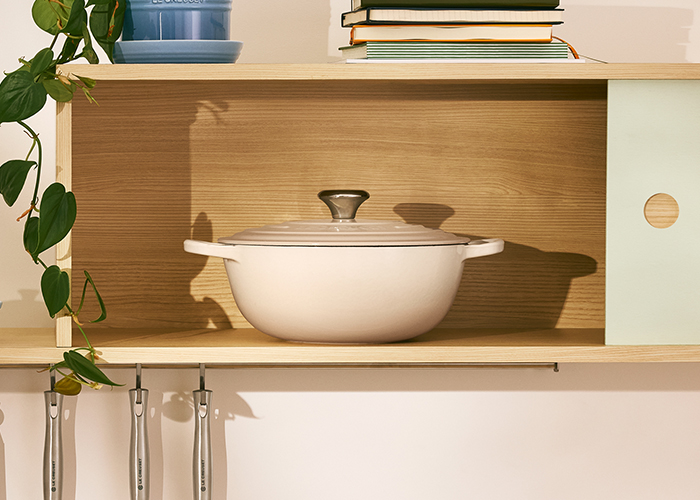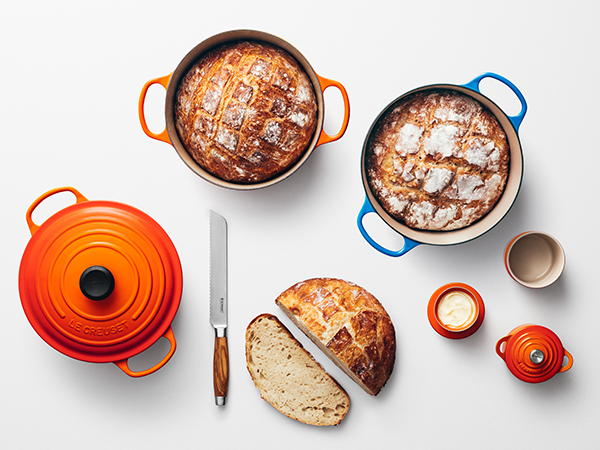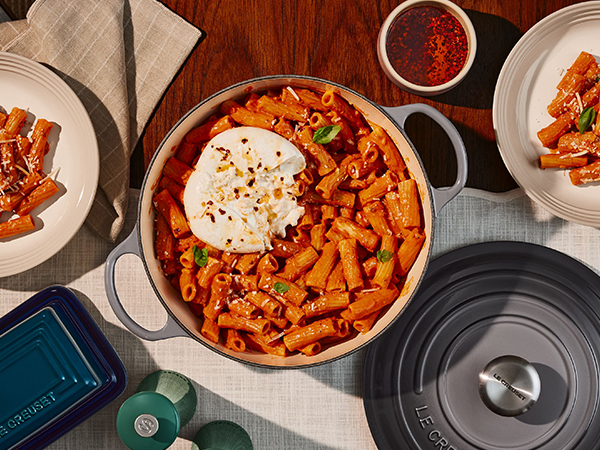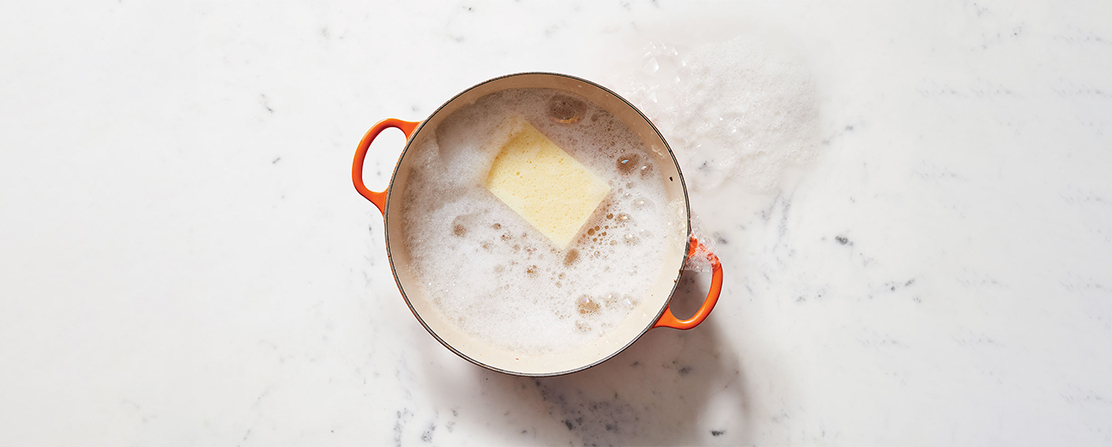
The Dutch Oven can quickly become your most used piece of cookware, and with good reason. This iconic piece of cookware epitomizes versatility and can be used for a variety of your favourite recipes and cooking techniques including, braising, searing, slow-cooking, sauteing, simmering, and even baking.
Crafted with enamelled cast iron, the Dutch Oven is built to last everyday use, offering superior heat retention and even heat distribution. Taking proper care of your Dutch Oven, however, can make a world of difference for its durability and ensuring its performance for years to come. While Le Creuset’s enamel is the most durable on the market, thermal shock due to improper care and use could still occur if you are not careful. Knowing the best ways to clean your cookware can make the whole process quicker and more enjoyable
Here is how to clean your Dutch Oven, including the materials you’ll need and the five steps to taking care of this iconic piece of cookware.

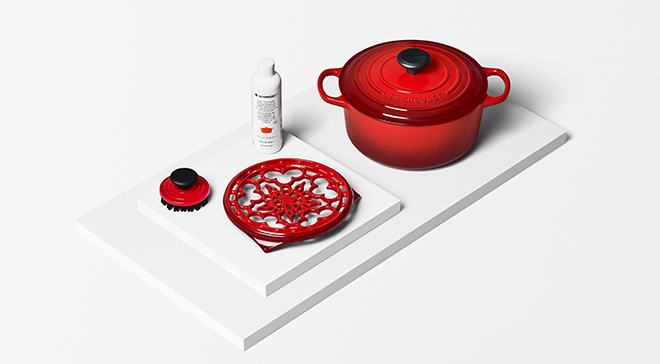
What you’ll need to clean your Dutch Oven
Before you can clean your Dutch Oven, ensure you have the following items for the best results:
1) Le Creuset’s Cookware Cleaner is perfectly suited for removing stubborn food residues and restoring the enamel’s shine and is recommended to clean your Dutch Oven.
2) Soft non-abrasive brushes and pads are best when cleaning the Dutch Oven, or any other piece of enamelled cast iron cookware and will not compromise the enamel. Featuring tough, durable bristles, our Nylon Brush is ideal for safely removing stuck-on foods from your Dutch Oven.
Five Steps to Cleaning Your Dutch Oven
Now that you have equipped yourself with all the enamelled cast iron cookware cleaning essentials, it is time to clean your Dutch Oven. Simply follow these five steps and your Dutch Oven will be preparing delicious recipes for the whole family for years to come.
This iconic piece of cookware is crafted with enamelled cast iron, ensuring its durability, but it nonetheless needs to be treated with care to avoid thermal shock or scratching the surface.
First, let the Dutch Oven cool down for a few minutes before adding water. Next, add baking soda into the Dutch Oven and bring to a rolling simmer for 8 to 10 minutes. Any remaining food residues should be released, otherwise, a wooden spatula can be used to remove stuck-on foods.
Most of the food residue should be removed following the water and baking soda mixture, however, it is possible that stuck-on foods remain. If this is the case, gently scrape off residues with a Nylon Brush. The interior enamel surface is sensitive and does not require intense scrubbing.
Soft non-abrasive pads and brushes are recommended for this step, as well as wooden utensils. Our Nylon Brush features tough and durable bristles and is specifically designed to remove stuck-on messes safely from enamelled cast iron cookware.
This should remove all stubborn food residues without compromising the integrity of the cooking surface. Our Cookware Cleaning Kit can be used for stuck-on foods and is also perfect for removing heat stains, discoloration, grit, and grime. Specifically designed for enamelled cast iron cookware, our cleaner is ideal for cleaning your Dutch Oven.
The next step to cleaning your Dutch Oven is taking care of the outside. While the tight-fitting lid is designed to lock in heat and prevent splatter, it can nonetheless still occur when simmering a sauce or stirring a soup. Typically, mixing hot soapy water and baking soda is recommended for this step. Once the mixture has been adequately mixed, you can begin gently scrubbing the outside of the Dutch Oven.
Do not use metallic pads or abrasive cleaning agents for this step as it can compromise the exterior enamel. Instead, nylon or soft-abrasive pads are best suited to tackling any messes on the exterior of the Dutch Oven
The Dutch Oven is dishwasher safe, yet constant dishwashing can lead to the dulling of the enamel over time. However, using the dishwasher to clean your Dutch Oven from time to time is not harmful and will not impair performance.
With stuck-on food bits removed, you can proceed to one of the final steps to cleaning your Dutch Oven. Arguably the easiest of them all, simply rinse your Dutch Oven off one final time in hot soapy water and rinse any cookware cleaner or baking soda mixture off. At this point, your Dutch Oven should be shining and looking brand new once again.
Ensuring the cooking surface is completely clean before storing it will guarantee its durability and performance for years to come. Once the Dutch Oven has been rinsed, set it aside to dry before storing or hanging it.
Your job is almost done once the Dutch Oven is free from all stubborn food residues. Before storing your Dutch Oven, ensure it is completely dry by wiping it down with a paper towel or a kitchen towel. Do not store this iconic piece of cookware, or any pans for that matter, while they are still damp.
Typically, we recommend storing your Dutch Oven in a dry cupboard or in an airy space away from steam. Available in a variety of bold colours, this versatile piece of cookware can even be hung from a pot rack or can directly be placed on your stovetop to compliment or contrast your existing kitchen decor. When it is not being used to prepare delicious meals, it can be used as a serving dish, a flower vase, and a number of other unconventional uses.
Dutch Oven vs. French Oven
Dutch Oven and French Oven are often used interchangeably given how similar these pieces of cookware are, however, have one key difference. In fact, Le Creuset refined the original Dutch Oven design from the 18th century, replacing the pure cast iron with enamelled cast iron to create the French Oven. This subtle change in material resulted in better heat retention and increased durability. It is also commonly referred to as a Cocotte.
Taking care of your Dutch Oven
Le Creuset’s Dutch Ovens are among the most durable pieces of cookware on the market, featuring enamelled cast iron, but nonetheless need to be looked after with care. A little care ultimately goes a long way at ensuring its durability for generations.
From soaking it with water and baking soda, to never plunging the Dutch Oven in cold water directly after use, these steps will arm you with both the best and safest way to clean your Dutch Oven for years to come. This iconic piece of cookware can be used to prepare recipes for the whole family and will undoubtedly be a staple in your household for years to come.
We hope our complete guide on how to clean your Dutch Oven has helped, but if you have any additional questions, our care and use section and blog has you covered with additional tips and tricks.
Our most-loved Dutch Ovens
Round Dutch Oven
A timeless classic, the round Dutch oven is ideal for everything from soups and stews to no-knead bread. Its compact, symmetrical shape allows for even heat distribution and fits perfectly on all stovetops, including induction. It’s the go-to size for everyday meals and a favourite among home cooks and chefs alike.
Its enamelled interior makes cleanup simple: no seasoning required, and residue wipes away with ease.
Buy nowOval Dutch Oven
With its elongated shape, the oval Dutch oven is perfect for roasting longer cuts of meat like pork loin or whole poultry. It offers ample space without compromising on heat retention, and its elegant silhouette transitions beautifully from oven to table. A must-have for slow-cooked comfort meals.
Cleaning is a breeze thanks to the smooth enamel surface that resists sticking and staining, even after hours of slow cooking.
Buy nowChef’s Dutch Oven
Designed with higher, sloped sides and a slightly curved base, the Chef’s Dutch oven is made for stirring, sautéing, and simmering. It's especially handy for recipes that require frequent movement, like risottos or hearty sauces. A versatile piece that blends the best features of a saucepan and a Dutch oven.
Easy to clean, its rounded interior allows utensils to reach every corner, while the enamel finish releases food effortlessly.
Buy nowDutch Oven Recipes Worth the (Easy) Cleanup
Dutch Oven Care FAQs
A Dutch oven is best cleaned by soaking it with water and baking soda, then gently simmering to loosen stuck-on food. Use soft, non-abrasive brushes or pads to remove residues without damaging the enamel. Rinse thoroughly with warm soapy water, dry completely, and store in a dry place. For more tips, see our Care and Use FAQ.
Enameled cast iron cookware should be cleaned with mild detergent and soft brushes or sponges to protect the enamel finish. For stubborn stains, soak with baking soda and water before gently scrubbing. Avoid abrasive cleaners or metal utensils that can scratch the surface; Le Creuset’s Cookware Cleaner is perfect for removing tough residues and restoring the enamel’s shine.
Le Creuset Dutch ovens are dishwasher safe, but frequent dishwasher use can dull the enamel over time. Hand washing with gentle cleaning agents is recommended to preserve the cookware’s shine and durability longer.
Use mild dish soap, warm water, baking soda for soaking, and soft nylon brushes or non-abrasive pads designed for enamelled cookware. Le Creuset’s specialized Cookware Cleaner is ideal for removing tough food residues and restoring enamel shine.


